.
30.05.2015
Long launch queue at SHAR
The Satish Dhawan Space Centre, ISRO’s rocket launch centre located at Sriharikota, has a busy year ahead.
On July 10, the Polar Satellite Launch Vehicle PSLV C28 is scheduled to launch three satellites designed by the U.K. for disaster management. This will be followed soon after by the test flight of the RLV-TD (Reusable Launch Vehicle- Technology Demonstrator) from the same launch pad, and the launch of the PSLV C30 carrying the Astrosat satellite designed to serve as a space observatory.
ISRO is expected to cross a major milestone in August when it launches the GSLV- D6 powered by the indigenously developed cryogenic upper stage. The assembly of the engine is on at Mahendragiri, VSSC Director M.C. Dathan told reporters here on Friday.
In January and February 2016, ISRO will launch the satellites that are part of the Indian Regional Navigation Satellite System (IRNSS) aboard the PSLV C29 and C30 rockets.
Developmental flight
The first developmental flight of the Geosynchronous Satellite Launch Vehicle, GSLV Mark 3, a landmark event for ISRO, is scheduled for December 2016. The biggest rocket made in India, the Mk3 carries an indigenous cryogenic engine for the upper stage. “Tests on the cryo stage are progressing. The mock trial is expected by mid- 2016. If successful, it will give us confidence to launch the Insat, GSAT series of satellites into orbit on our own”, Mr. Dathan said.
---
ISRO developing heavy lift launch vehicles
The Indian Space Research Organisation (ISRO) is developing a series of heavy lift launch vehicles (HLV) capable of lofting satellites up to 10 tonnes into the orbit.
Mindful of the need to keep development costs under control, we have adopted a modular approach to the design of the HLV, Vikram Sarabhai Space Centre Director M.C. Dathan told mediapersons here on Friday. “While the GSLV Mk3, scheduled to undergo operation flight test in December 2016, will be capable of carrying satellites up to four tonnes, the standard size of satellites is expected to go up to six tonnes in the near future, requiring rockets with more heft,” he explained.
ISRO is toying with the idea of adding a semi-cryogenic stage to the GSLV Mk3 to generate a lift up to six tonnes. A more powerful cryo upper stage is expected to add the required muscle to handle satellites up to 10 tonnes. “What we have in mind is a progressive development to come up with need-based variants of the Mk3 instead of coming up with a new rocket altogether,” Mr. Dathan said.
Explaining the rationale behind the modular approach, he said the miniaturisation of electronics could lead to the development of lighter satellites requiring lesser lift capability. “This is where the modular design makes sense.”
Mr. Dathan said ISRO was developing an orbiter, lander, and rover for Chandrayaan-2, India’s second mission to the moon planned for 2017. “The initial proposal for a Russian lander was dropped after they changed the design, making it too heavy for the PSLV rocket.”
Quelle: The Hindu
.
Update: 4.07.2015
.
ISRO to undertake biggest commercial launch on July 10
n the heaviest ever commercial mission undertaken by ISRO and its commercial arm Antrix, the country's workhorse the Polar Satellite Launch Vehicle (PSLV) will put in orbit five foreign satellites from the spaceport of Sriharikota in Andhra Pradesh on July 10.
With the overall lift-off mass of the five satellites amounting to about 1,440 kg, this mission becomes the heaviest commercial mission ever undertaken by Antrix/ISRO, the Indian space agency said.
In its 13th flight, PSLV-C28 will launch three identical DMC3 optical earth observation satellites built by Surrey Satellite Technology Limited (SSTL), United Kingdom (UK).
The three DMC3 satellites, each weighing 447 kg, will be launched into a 647 km Sun-Synchronous Orbit (SSO) using the high-end version of PSLV (PSLV-XL), ISRO said on its website. PSLV-C28 will be the ninth flight of PSLV in 'XL' configuration.
In addition, the rocket will also carry two auxiliary satellites from UK - CBNT-1, a technology demonstrator earth observation micro satellite built by SSTL, and De-OrbitSail, a technology demonstrator nano satellite built by Surrey Space Centre, it said.
Accommodating the three DMC3 satellites each with a height of about 3 metre within the existing payload fairing of PSLV, was a challenge, ISRO said.
To mount these satellites onto the launcher, a circular Launcher adaptor called L-adaptor and a triangular deck called Multiple Satellite Adapter-Version 2 (MSA-V2), were newly designed and realised by ISRO for this specific purpose.
These international customer satellites are being launched as part of the arrangement entered into between DMC International Imaging (DMCii), a wholly owned subsidiary of SSTL, UK; and Antrix Corporation Limited (Antrix), it said.
The DMC3 constellation, comprising three advanced mini-satellites DMC3-1, DMC3-2 and DMC3-3, is designed to address the need for simultaneous high spatial resolution and high temporal resolution optical Earth Observation.
Launched into a single Low-Earth Orbit plane and phased with a separation of 120 degrees between them, these satellites can image any target on the Earth’s surface every day. Major application areas include surveying the resources on earth and its environment, managing urban infrastructure and monitoring of disasters.
CBNT-1, weighing 91 kg, is an optical Earth Observation technology demonstration micro satellite built by SSTL. The 7 kg De-orbitSail from Surrey Space Centre, is an experimental nano satellite for demonstration of large thin membrane sail and drag deorbiting using this sail.
Quelle: DECCAN HERALD
-
Update: 6.07.2015
.
Isro to Launch 5 British Satellites on Friday
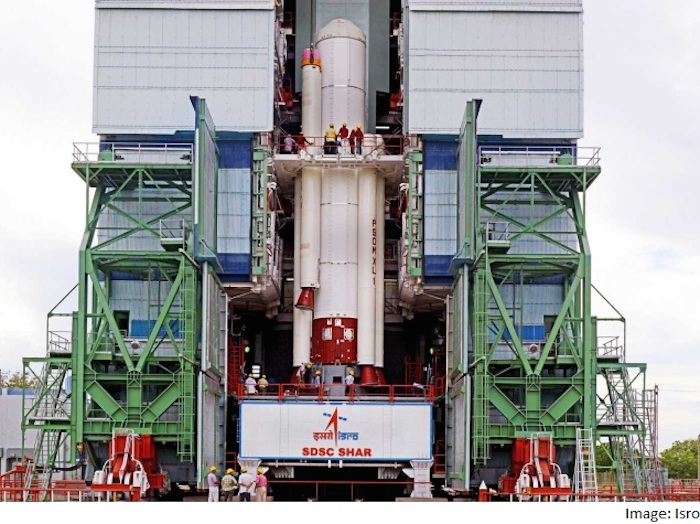
As an Indian rocket is getting ready to put five British satellites into orbit on July 10, officials at the Sriharikota space port are also working on an Indian satellite launch, an official said on Monday.
India will launch a communications satellite GSAT6 sometime after July 10.
"Work is progressing smoothly for the July 10 night rocket launch. The PSLV (polar satellite launch vehicle) rocket is ready. We are carrying out the launch rehearsal now. We will be rehearsing the activities that are to be done on the launch day," a senior official of Indian Space Research Organisation (Isro) told IANS on Monday.
According to him, the four stage/engine PSLV rocket in XL variant is slated to blast off at 9:58pm on July 10 and the 62.5-hour countdown is expected to start at 7:28 am IST on July 8.
The official said the Launch Authorisation Board (LAB) is slated to meet on July 7 and take a decision on the PSLV rocket launch.
Of the five British satellites, together weighing around 1,440kg, three are identical DMC3 optical earth observation satellites weighing 447kg. These will be put into a 647km sun-synchronous orbit.
Of the other two satellites, CBNT-1 weighs 91kg and also is an optical earth observation technology demonstration microsatellite, while the De-OrbitSail weighs 7kg. This is an experimental nano satellite for demonstration of large thin membrane sail and drag deorbiting.
The three DMC3 and the CBNT-1 satellites are built by Surrey Satellite Technology Ltd. The De-OrbitSail is built by Surrey Space Centre.
According to Isro , accommodating the three DMC3 satellites each with a height of about three metres within the existing payload fairing or the heat shield of the PSLV was a challenge. Thus, a circular L-adaptor and a triangular Multiple Satellite Adapter-Version 2 (MSA-V2) were newly designed and realised by Isro for this specific purpose.
France's SPOT 7 satellite weighing 714kg was the heaviest single foreign satellite carried by a PSLV rocket till now. It was launched on June 30, 2014.
Meanwhile, the GSAT6 communication satellite is expected to reach Sriharikota space port on July 6 after it was flagged off from Bengaluru, the official said on the condition of anonymity.
He said the GSAT6 communication satellite will be put into space aboard a heavier rocket called geosynchronous satellite launch vehicle (GSLV).
The GSLV rocket's first stage/engine has been assembled and the activities relating to that rocket assembly are progressing smoothly.
Only after the GSLV rocket launch the testing of a small model of reusable launch vehicle shaped like an aeroplane would be done, the Isro official said.
Earlier, it was said the test reusable launch vehicle would happen in July 2015.
Isro officials had told IANS that the test model reusable launch vehicle would be mounted on a strap-on solid booster of PSLV rocket with 9-tonne fuel.
At an altitude of 70km, the model would get separated and would glide back to earth. The descent speed would be around 2 kilometres per second.
"The descent speed would be controlled through the fins on the machine. In order to protect the equipment from friction heat when it comes back, necessary protective tiles are fixed," the Isro official had told IANS.
The experimental vehicle would weigh around 1.5 tonne which is a far cry from the actual vehicle that is expected to carry a satellite.
In December 2014, Isro sent up a 3.7-tonne giant cup cake shaped module - called Crew Module Atmospheric Re-entry Experiment - to study its re-entry characteristics, aero-braking and validation of its end-to-end parachute system.
A 630-tonne rocket went up to 126km when the crew capsule got detached and fell into the Bay of Bengal, 20 minutes after the blast off.
The descent speed of the crew module was controlled by three parachutes.
However, the aircraft shaped vehicle will not have any parachutes to control the descent speed but the fins and other parts would do so.
Quelle: NDTV
-
Update: 9.07.2015
.
ISRO to launch heaviest commercial mission tomorrow
Its workhorse will lift-off 44.4 metre tall PSLV-XL version from the Satish Dhawan Space Centre at Sriharikota and would put into orbit five satellites
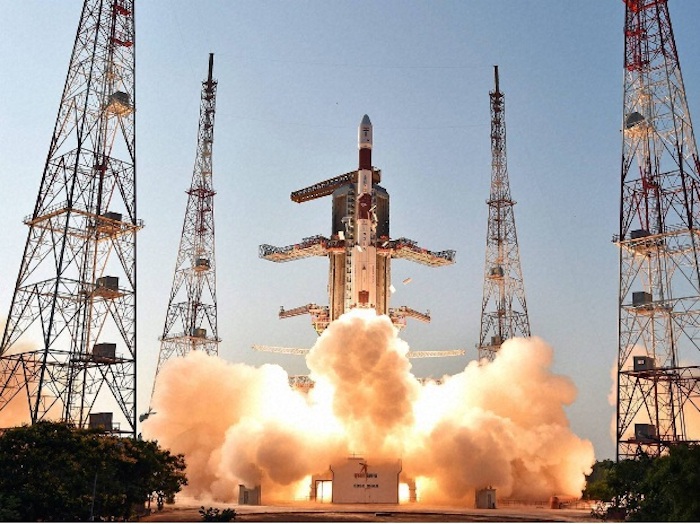
Indian space agency ISRO is all set to launch its heaviest commercial mission that would put five British satellites on board PSLV-C28 from the spaceport of Sriharikota near here tomorrow.
The 62.5 hour countdown began yesterday at 07.28 AM and was progressing smoothly for the launch scheduled for 09.58 PM tomorrow, ISRO officials said.
Indian Space Research Organisation's workhorse would lift-off 44.4 metre tall PSLV-XL version from the Satish Dhawan Space Centre at Sriharikota and would put into orbit five satellites.
With the overall mass of five satellites is about 1,440kg, this launch becomes the "heaviest commercial mission" ever undertaken by ISRO and its commercial arm Antrix Corporation.
PSLV, in its 30th mission, would launch three identical DMC3 optical earth observation satellites, built by Surrey Satellite Technology Limited (SSTL), United Kingdom, and two auxiliary satellites.
The three DMC3 satellites, each weighing 447 kg, will be launched into a 647 km Sun-Synchronous Orbit (SSO) using the high-end version of PSLV-XL.
The earlier successful launches by ISRO -- Mars Orbiter Mission which was launched in November 5, 2013 and the Chandrayaan-1 launched in October 22, 2008 were with similar PSLV-XL variants.
PSLV C28, in addition to the three DMC3 satellites, will also carry two auxiliary satellites from UK -- CBNT-1, a technology demonstrator earth observation micro satellite built by SSTL, and De-OrbitSail, a technology demonstrator nano satellite built by Surrey Space Centre.
The five satellites are being launched as part of the arrangement entered into between DMC International Imaging (DMCii), a wholly owned subsidiary of SSTL, UK and Antrix Corporation Limited.
The DMC3 constellation, comprising three advanced mini-satellites DMC3-1, DMC3-2 and DMC3-3, is designed to address the need for simultaneous high spatial resolution and high temporal resolution optical Earth Observation.
These satellites can image any target on the Earth's surface every day. Major application areas include surveying the resources on earth and its environment, managing urban infrastructure and monitoring disasters.
The life of the mission is seven years.
Quelle: BS
.
Update: 10.07.2015 / 15.00 MESZ
-
Start von PSLV-28
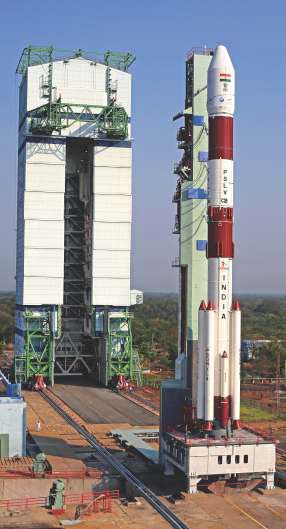
PSLV C28 / DMC3 Update: Propellant filling operations are completed. Countdown operations are progressing normally.
.
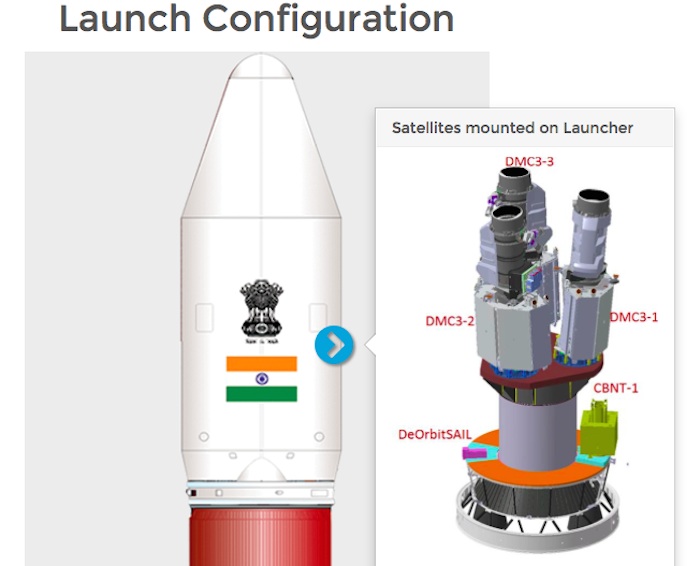
.
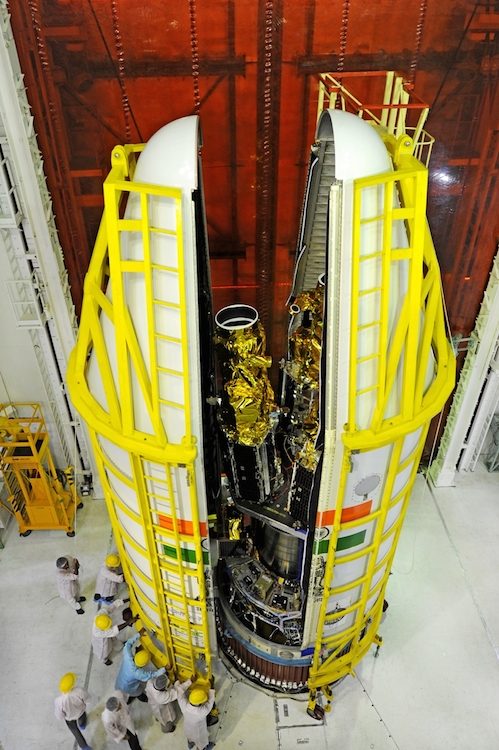
Quelle: ISRO
...
Erfolgreicher Start von PSLV-28
.
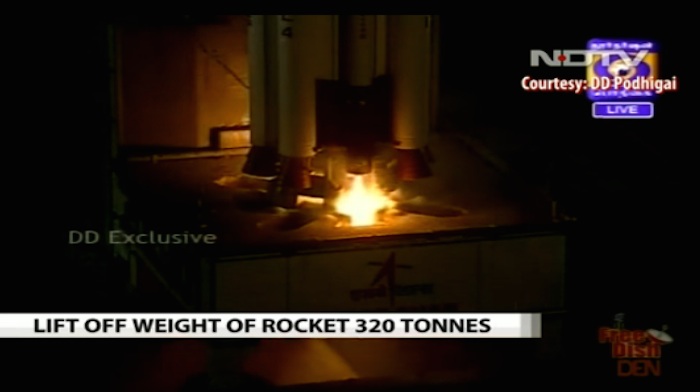
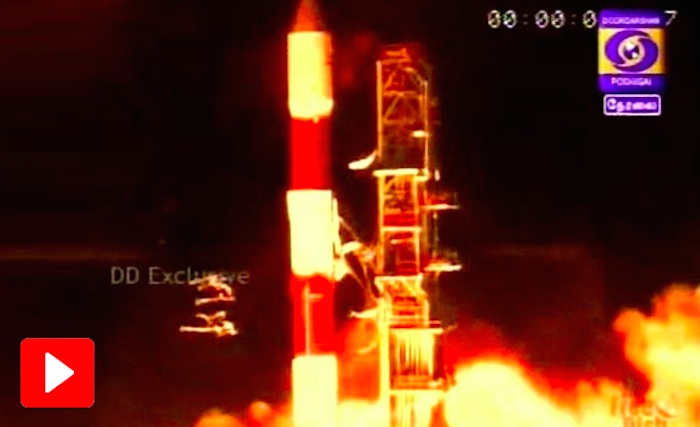
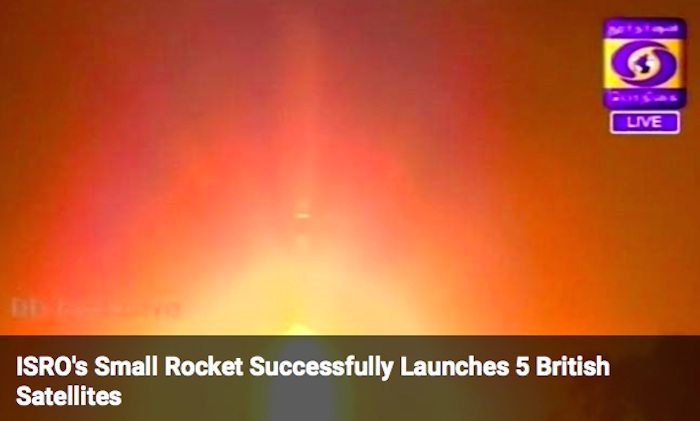
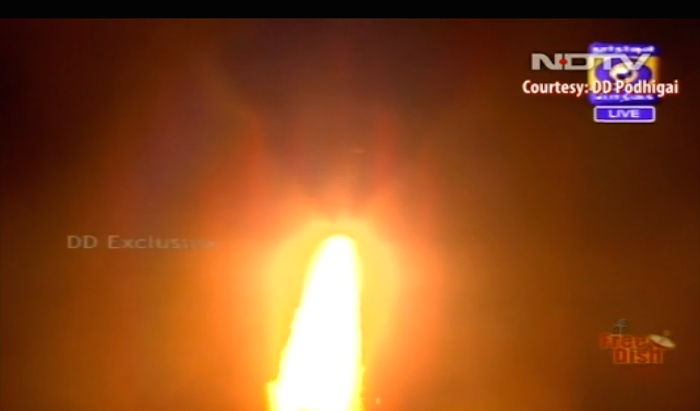
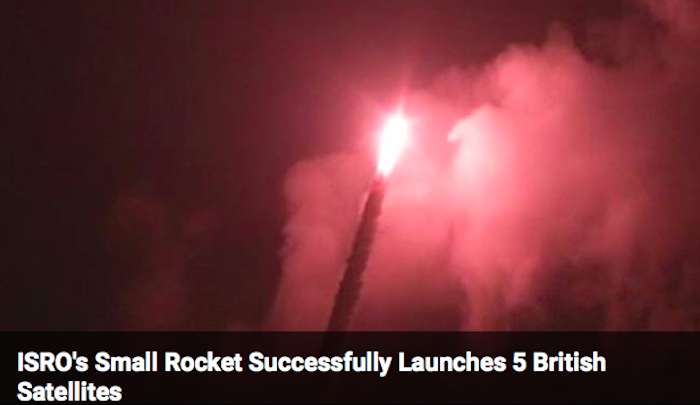
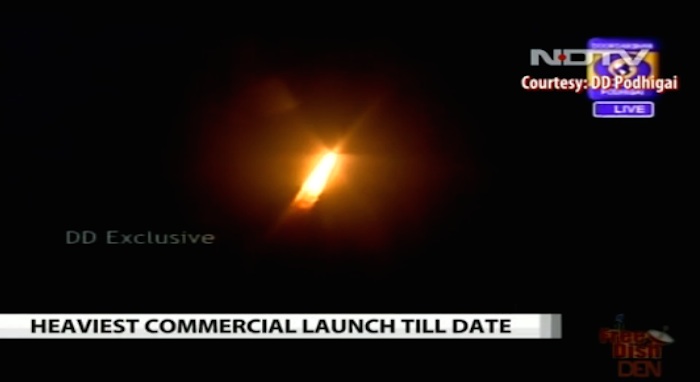
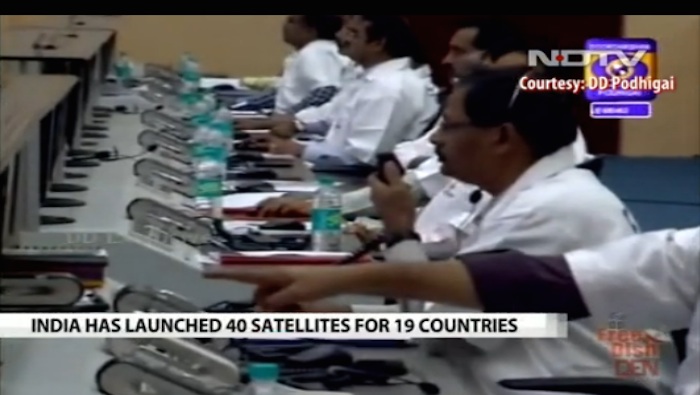
Quelle: NDTV
-
Update: 12.07.2015
-
PSLV Successfully Launches Five Satellites from UK
In its thirtieth flight, conducted from Satish Dhawan Space Centre (SDSC) SHAR, Sriharikota today night (July 10, 2015), ISRO's Polar Satellite Launch Vehicle PSLV-C28 successfully launched three identical DMC3 commercial Earth Observation Satellites, along with two smaller satellites from United Kingdom, into a polar Sun Synchronous Orbit which was very close to the intended orbit of 647 km height. The five satellites together weighed about 1440 kg at lift-off.
These five satellites were launched as part of the agreement entered into between DMC International Imaging (DMCii), a wholly owned subsidiary of Surrey Satellite Technology Limited (SSTL), UK and Antrix Corporation Limited, the commercial arm of the Indian Space Research Organisation (ISRO), a government of India Company under the Department of Space (DOS). This was the twenty ninth consecutively successful flight of PSLV.
PSLV was launched today in its heaviest ‘XL’ version with six strap-on motors of the first stage. This flight was unique since for the first time, the ‘XL’ version of PSLV was used to launch foreign payloads exclusively. Till now, the lighter ‘core alone’ version of PSLV has been used to launch foreign payloads exclusively. PSLV has successfully launched 45 satellites for customers from abroad including five UK satellites launched today.
Through 29 successful flights during 1994-2015 period, PSLV has launched a total of 77 satellites with a total mass of 32.04 tons, of which 4.64 tons (about 14%) comprises 45 satellites for customers from abroad. The vehicle has repeatedly proved its reliability and versatility by successfully launching satellites into a variety of orbits including polar Sun Synchronous, Geosynchronous Transfer and Low Earth orbits thereby emerging as the workhorse launch vehicle of India.
After a 62.5 hour smooth count down, the 320 ton PSLV-C28 lifted off from the First Launch Pad (FLP) at SDSC SHAR at 2158 hrs (9:58 pm) IST with the ignition of its first stage. The important flight events included the ignition and separation of strap-ons, separation of the first stage, ignition of the second stage, separation of the payload fairing at about 118 km altitude after the vehicle had cleared the dense atmosphere, second stage separation, third stage ignition and third stage separation, fourth stage ignition and fourth stage cut-off.
Once in proper orbit, the three DMC3 satellites were successfully deployed about 18 minutes after lift-off in quick succession. Following this, the 7 kg Nanosatellite De-OrbitSail and the 91 kg Microsatellite CBNT-1 were also successfully deployed.
Today’s successful commercial launch of PSLV further underscores the country’s capability in launch vehicle technologies
.
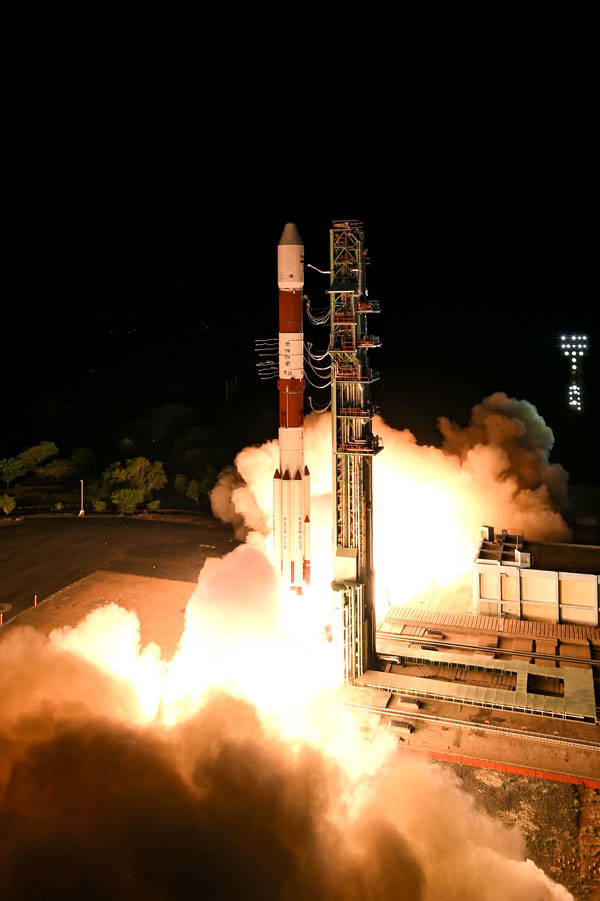
-
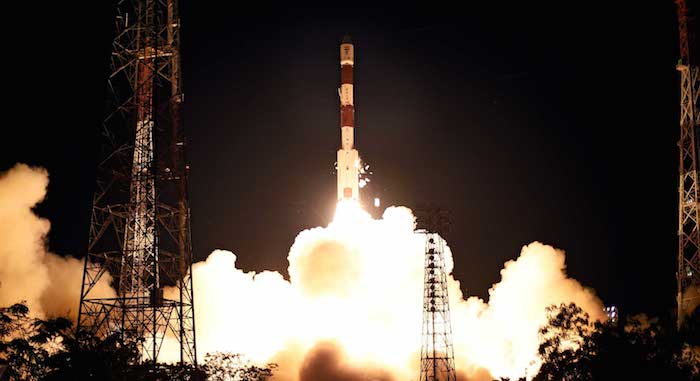
-
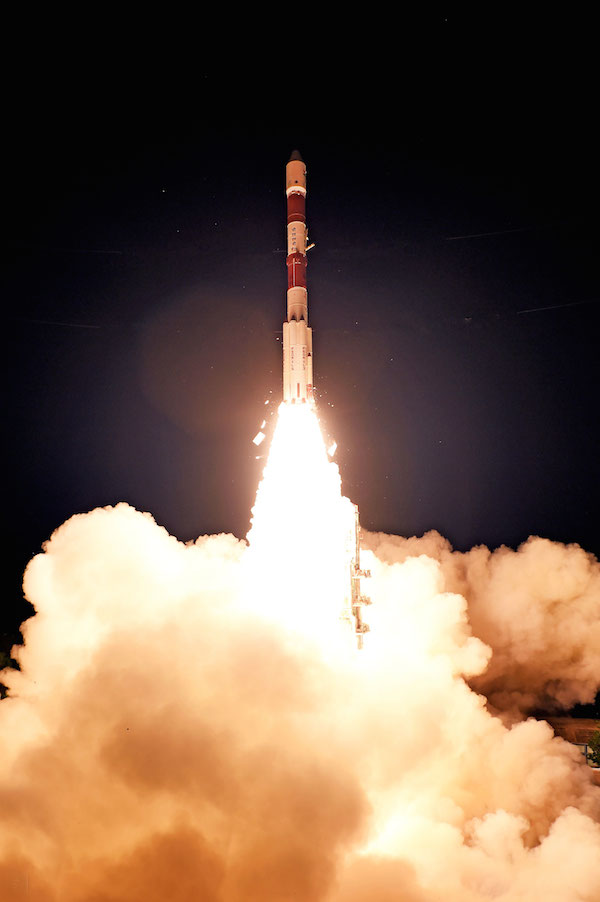
Quelle: ISRO
4362 Views
